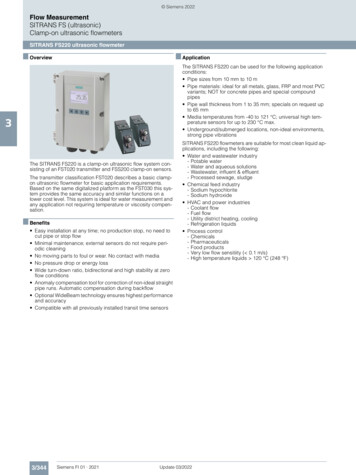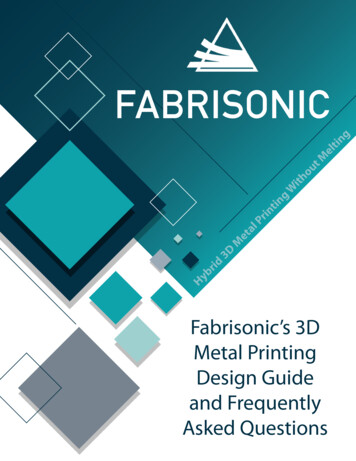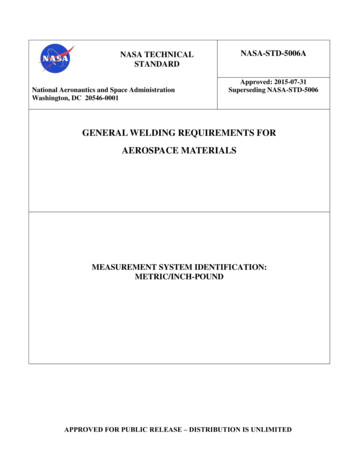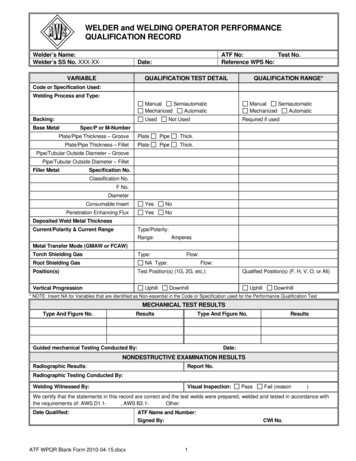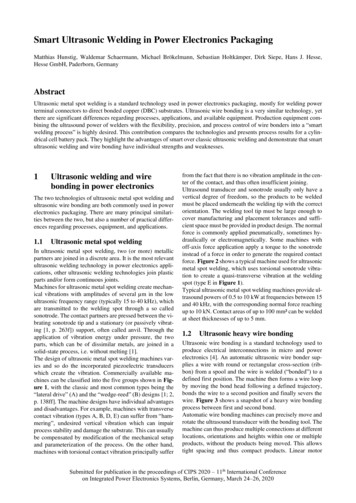
Transcription
Smart Ultrasonic Welding in Power Electronics PackagingMatthias Hunstig, Waldemar Schaermann, Michael Brökelmann, Sebastian Holtkämper, Dirk Siepe, Hans J. Hesse,Hesse GmbH, Paderborn, GermanyAbstractUltrasonic metal spot welding is a standard technology used in power electronics packaging, mostly for welding powerterminal connectors to direct bonded copper (DBC) substrates. Ultrasonic wire bonding is a very similar technology, yetthere are significant differences regarding processes, applications, and available equipment. Production equipment combining the ultrasound power of welders with the flexibility, precision, and process control of wire bonders into a “smartwelding process” is highly desired. This contribution compares the technologies and presents process results for a cylindrical cell battery pack. They highlight the advantages of smart over classic ultrasonic welding and demonstrate that smartultrasonic welding and wire bonding have individual strengths and weaknesses.1Ultrasonic welding and wirebonding in power electronicsThe two technologies of ultrasonic metal spot welding andultrasonic wire bonding are both commonly used in powerelectronics packaging. There are many principal similarities between the two, but also a number of practical differences regarding processes, equipment, and applications.1.1Ultrasonic metal spot weldingIn ultrasonic metal spot welding, two (or more) metallicpartners are joined in a discrete area. It is the most relevantultrasonic welding technology in power electronics applications, other ultrasonic welding technologies join plasticparts and/or form continuous joints.Machines for ultrasonic metal spot welding create mechanical vibrations with amplitudes of several µm in the lowultrasonic frequency range (typically 15 to 40 kHz), whichare transmitted to the welding spot through a so calledsonotrode. The contact partners are pressed between the vibrating sonotrode tip and a stationary (or passively vibrating [1, p. 263f]) support, often called anvil. Through theapplication of vibration energy under pressure, the twoparts, which can be of dissimilar metals, are joined in asolid-state process, i.e. without melting [1].The design of ultrasonic metal spot welding machines varies and so do the incorporated piezoelectric transducerswhich create the vibration. Commercially available machines can be classified into the five groups shown in Figure 1, with the classic and most common types being the“lateral drive” (A) and the “wedge-reed” (B) designs [1; 2,p. 138ff]. The machine designs have individual advantagesand disadvantages. For example, machines with transversecontact vibration (types A, B, D, E) can suffer from “hammering”, undesired vertical vibration which can impairprocess stability and damage the substrate. This can usuallybe compensated by modification of the mechanical setupand parameterization of the process. On the other hand,machines with torsional contact vibration principally sufferfrom the fact that there is no vibration amplitude in the center of the contact, and thus often insufficient joining.Ultrasound transducer and sonotrode usually only have avertical degree of freedom, so the products to be weldedmust be placed underneath the welding tip with the correctorientation. The welding tool tip must be large enough tocover manufacturing and placement tolerances and sufficient space must be provided in product design. The normalforce is commonly applied pneumatically, sometimes hydraulically or electromagnetically. Some machines withoff-axis force application apply a torque to the sonotrodeinstead of a force in order to generate the required contactforce. Figure 2 shows a typical machine used for ultrasonicmetal spot welding, which uses torsional sonotrode vibration to create a quasi-transverse vibration at the weldingspot (type E in Figure 1).Typical ultrasonic metal spot welding machines provide ultrasound powers of 0.5 to 10 kW at frequencies between 15and 40 kHz, with the corresponding normal force reachingup to 10 kN. Contact areas of up to 100 mm² can be weldedat sheet thicknesses of up to 5 mm.1.2Ultrasonic heavy wire bondingUltrasonic wire bonding is a standard technology used toproduce electrical interconnections in micro and powerelectronics [4]. An automatic ultrasonic wire bonder supplies a wire with round or rectangular cross-section (ribbon) from a spool and the wire is welded (“bonded”) to adefined first position. The machine then forms a wire loopby moving the bond head following a defined trajectory,bonds the wire to a second position and finally severs thewire. Figure 3 shows a snapshot of a heavy wire bondingprocess between first and second bond.Automatic wire bonding machines can precisely move androtate the ultrasound transducer with the bonding tool. Themachine can thus produce multiple connections at differentlocations, orientations and heights within one or multipleproducts, without the products being moved. This allowstight spacing and thus compact products. Linear motorSubmitted for publication in the proceedings of CIPS 2020 – 11th International Conferenceon Integrated Power Electronics Systems, Berlin, Germany, March 24–26, 2020
driven kinematics enable precise and fast movements, resulting in high speed processes with multiple wire bondsper seconds. The normal force is applied by a precise electromagnetic actuator, allowing the normal force to be controlled and changed dynamically during the bonding process.normalforce(type D in Figure 1), the physical joining process is identical. For this reason, ultrasonic wire bonding is sometimescalled “ultrasonic micro welding” [5]. In microelectronicapplications, wire bonding uses about 1 W of ultrasoundpower at frequencies between 60 and 150 kHz. Typicalwire bonding machines for power applications work withmaximum nominal powers of 100 W at frequencies between 40 and 100 kHz. Depending on material, these machines can process round wire diameters of up to 600 µmand ribbon cross-sections up to 400 x 2000 µm². Typicalmaterials are Al, Cu, and Al-clad anvilanvil(side view)(side view)(A) transverse contact vibrationfrom directly applied longitudinal sonotrode vibration; normalforce (or torque) applied off-axis(“lateral drive design”).(B) transverse contact vibrationfrom longitudinal sonotrode vibration, transmitted through bending beam; normal force appliedaxially (“wedge-reed vibrationFigure 2 Ultrasonic metal spot welding using a TelsonicMPX machine, working at 20 kHz with a maximum powerof 6.5 kW (image from [3], used under license CC BY 4.0,cropped and label removed)anvil(front view side view)vibrationanvil(side view)(top view)(C) torsional contact vibration (D) transverse contact vibrationfrom torsional sonotrode vibra- from longitudinal sonotrode vition; normal force applied axially bration, transmitted through bending beam; normal force appliedoff-axisnormalforceFigure 3 Heavy copper wire bonding on test substratesonotrodesonotrodevibrationanvil(front view)anvil(side view)(E) transverse contact vibration from torsional sonotrode vibration;normal force applied off-axisFigure 1 Types of ultrasonic metal spot welding machinesThe bonding process itself is principally a very low powerultrasonic metal spot welding process using a machine withtransverse vibration transmitted through a bending beamAn automatic ultrasonic wire bonding machine could thusbe described as a conventional ultrasonic spot welding machine with low power and extended functionality. This includes fast and precise movement of the transducer in fouraxes, freely programmable courses of ultrasound vibrationamplitude and normal force, and supplying, forming, andsevering the wire. Current automatic wire bonding machines also include advanced functions not common tometal spot welding equipment. Some of these functions,such as pattern recognition, touchdown sensing, and normal force control, are mandatory to produce reliable connections between the small wires and the often sensitivesubstrates. Other features, such as diverse advancedSubmitted for publication in the proceedings of CIPS 2020 – 11th International Conferenceon Integrated Power Electronics Systems, Berlin, Germany, March 24–26, 2020
process control functions, standardized interfaces for assembly line integration, and the flexibility to handle a largevariety of products and layouts with one series machine bya mere change of clamping and programming, provide theuser with increased control and flexibility.1.3Applications in power electronics packagingTypical power electronics packaging applications for ultrasonic metal spot welding are terminals and power contacts,e.g. in IGBT or inverter modules, as well as busbar connections. Such ultrasonic welding is only used on robustpassive material such as DBC and terminals, while heavywire bonding is also commonly used to produce connections on sensitive active substrates such as chips, even withhard wire material such as copper [6, 7]. In fact, manypower modules use wire bonding for internal connections,e.g. die to die, die to DBC, and higher power ultrasonicwelding for connecting the external power contacts. Figure 4 shows an example of such a combination. Wire bonding is also increasingly used in the production of Li-ionbattery packs [8].Figure 4 Section of a power module combining Al wirebonds and ultrasonically welded Cu power contacts (imagecourtesy of Infineon Technologies AG)1.4observed quantities are outside certain limits, a joint is regarded as suspicious. Such tests do not consume any timeand can thus be applied to 100 % of the joints. As tests haveshown that not all bad wire bonds could be identified usingcurrent and deformation alone [9, 10], frequency observation is very common in wire bonding nowadays. Still, thisdoes not guarantee identification of all potentially badwelds. Thus, more advanced quality control systems useadditional independent quantities to determine joint quality.One such system, productively used in wire bonders forseveral years, is the multidimensional Process integratedQuality Control (PiQC) [9, 10]. Using an additional sensorintegrated into the ultrasound transducer, it evaluates fivedifferent physical quantities over the whole length of theprocess: mechanical vibration of the welding tool, frictionin the welding zone, wire deformation, transducer impedance, and operation frequency, i.e. transducer resonancefrequency. From their course over the process time, it calculates quality indices for each of these quantities based ona previously learned set of reference welds representing agood, stable process. This process automatically excludesoutliers. The quality indices are calculated based on the deviation of each signal from the reference course, weightedby a learned statistical model of the individual process, using user-defined tolerance and sensitivity settings as shownin Figure 5. For each connection, a total quality index iscalculated from the five individual quality indices. A userdefined action limit is applied to the quality index. Allthese calculations happen in real-time and do not affect thetotal process time.A low quality index does not necessarily mean that a connection is bad, but that it is significantly different from thereference. But if this reference is a good, stable processproducing optimum results, any deviation is very likely toindicate a bad connection. This method is able to detectfailures such as incorrect tool mounting, contaminations,or misplaced welds, even if they were not detected by classic destructive testing such as shearing [9, 10].Quality controlBesides optical inspection, destructive and non-destructivemechanical tests like shear, pull, or peel tests are classicmethods to evaluate the joint quality of ultrasonic processes. Online observation of certain parameters over thecourse of the welding time is nowadays also common inclassic ultrasonic welding and standard in wire bonding.The following quantities are often evaluated: Electric current (if voltage is set) or voltage (ifcurrent is set) amplitude or impedance (relation ofvoltage to current) Electric power or energy Vertical deformation Vibration frequency (if resonance frequencytracking is used)Current, voltage, impedance, power, and energy are not independent quantities. Current, voltage, or impedance arecommonly observed in wire bonding, while power or energy are more common in ultrasonic welding. If any of theFigure 5 Calculation of individual quality indices frommean signal deviation relative to the learned statisticalmodel for the individual process, using parameters sensitivity s (default 50 %) and tolerance default 1.Submitted for publication in the proceedings of CIPS 2020 – 11th International Conferenceon Integrated Power Electronics Systems, Berlin, Germany, March 24–26, 2020
2Smart ultrasonic weldingIn principle, most wire bonding machines could be programmed to not use the wire handling functions and workas an ultrasonic welding machine with advanced functionality. But in such a scenario, the unused wire handling components would produce unnecessary costs and limit accessibility. Also, the maximum power of heavy wire bondersis too low for most current ultrasonic welding applications.Thus, there is a need for machines for what we call “smartultrasonic welding”, combining the force and ultrasoundpower of conventional ultrasonic welding machines withthe flexibility, precision, speed and process control featuresof state-of-the-art wire bonding machines.These include precise positioning and rotation, patternrecognition to detect the exact weld location, and derivation of an optimal trajectory to reach the weld locationquickly and very precisely. Together with long and slimwelding tools, this allows flexible layouts and very tightspacing, and thus more compact products or higher powerdensity in existing packages. Touchdown sensing, freelyprogrammable ultrasound and force courses, and precisecontact force control facilitate welding on sensitive substrates. Like ultrasonic wire bonders, smart welding machines can flexibly handle a large variety of products.3Case study: interconnections incylindrical cell battery packsAs a case study, we present and compare wire bonding and(smart) welding processes for a battery pack application.Ultrasonic joining has some advantages over other technologies for such applications. It does not require zero gap between lead frame and cell like laser welding as gaps areclosed automatically during the application of the initialnormal force, and it can handle high tolerances in height,position and orientation. It is insensitive to varying reflectivity or high thermal conductivity and has little heat effectand no heat affected zone, other than laser and resistancewelding. And it produces neither smoke nor splatter. Themain disadvantages of ultrasonic joining over these technologies are that it requires clean surfaces of constant quality and that the parts to be joined must be properly fixed fora reliable process.The case study was conducted using a Hesse MechatronicsSW955 (type D machine design, cp. Figure 1). This machine with a maximum ultrasound power of 200 W is capable of welding copper contacts up to about 2 mm² andmarks the low power end of a series of smart welders. Thismachine series shall provide producers of medium-sizedultrasonically welded connections with increased processcontrol and freedom of design for the next generation ofpower electronics, battery packs and other applications.Thy hybrid machine used for the tests handles both smartwelding and wire bonding.The power connections in the investigated battery packhave been produced using 500 µm Al (Heraeus Al-H11CR) wire bonds and ultrasonic welds of pre-placed Al (ENAW-Al 99.5 H12) lead frames. A third option for such anapplication, not investigated here, is ribbon bonding, i.e.wire bonding with rectangular cross-section wire. The packuses 4 x 6 passive (“dummy”) cells of size 21700 (21 mmdiameter, 70 mm height) in a 6p4s configuration (6 cells inparallel, 4 in series), resulting in a pack voltage of 4 x 3.6 V 14.4 V if real cells were used. It was developed by HesseMechatronics for demonstration purposes. Cap and crimpof the cells are made of nickel-coated steel, bus bars between the cells are made of AlMgSi0.5.3.1Connection layoutReferring to the top views in Figure 6, the produced interconnections connect the caps (positive electrodes) of thecells to the bus bar above and the crimps (negative electrodes) to the bus bar below. Thus, 48 weld connections areneeded to connect the 24 cells with pre-placed lead frames,cp. Figure 7(a) and Figure 6(a). With wire bonding, leadframes are obsolete, but the connecting wire must also bebonded to the bus bar. So called stitch bonds are used toconnect inner bus bars with a cap and a crimp using a singlewire and three bond connections. Thus, in this pack configuration with four rows of six cells each, a total of 78 bondconnections is needed – 24 on caps, 24 on crimps, 30 onbus bars, cp. Figure 7(a) and Figure 6(b). With increasingpack size, the share of inner bus bars increases, reducingthe share of single-connection wire bonds. The number ofbonds per cell is 3 1/n, with the number of rows of cells n.It is thus 3.25 in this example with n 4 and approaches,but never reaches, 3.In the welding process, any layout change requires a modification of the lead frame. With wire bonding, layoutchanges can be implemented in the bonding programwithin minutes.3.2Pattern recognitionPositioning accuracy requirements in battery pack manufacturing are typically less tight than in electronics manufacturing. Still, the connections must be placed at the correct positions to ensure a stable manufacturing process andelectrical functionality of the pack. This is true for both(smart) welding and wire bonding.In this use case, the positions of welds and wires were defined relative to the edges of the battery pack. Before welding a pack, its position is detected by pattern recognition oftwo corners. If necessary, e.g. in battery packs manufactured with less accuracy or if a very constant process resultis desired, pattern recognition can also detect the individualcells, but this takes more time and reduces throughput. Figure 6 shows the bonding/welding patterns as defined afterpattern recognition.Power electronics packages designed for classic ultrasonicmetal spot welding often include large clearance to compensate for coarse positioning of the product under a ratherbulky stationary welding tip. With pattern recognition andprecise positioning available in smart welders, these clearances can be minimized, enabling more compact designs.Submitted for publication in the proceedings of CIPS 2020 – 11th International Conferenceon Integrated Power Electronics Systems, Berlin, Germany, March 24–26, 2020
(a) smart welding processbe expected for a well-developed industrial process and notsuitable for a realistic comparison. Especially the materialof the lead frame appeared to be critical.Assuming welding times of 0.3 s for cap and crimp connections and 0.15 s for the simpler (Al on Al, rigid substrate) bus bar connections, an industrial smart weldingprocess would take 21.2 s, while wire bonding would take34.8 s, i.e. 64 % longer. But any comparison must considerthe longer process chain of smart welding, including leadframes placement, and the desired tact time in relation toautomation and loading. A practical comparison shouldalso always use real welding times and consider requiredcontact areas. In the investigated example, wire bond contact areas are about 0.5 mm², while lead frame welds areabout 1.3 mm².3.4Quality controlAs an example, the PiQC system described in section 1.4has been applied to the 24 cap welds with the tolerance set to 0 for demonstration purposes. A tolerance settingof 0 means that even the smallest deviation from thelearned reference results in a quality index below 100 %,cp. Figure 5. This is not practical for productive use, butmakes the variation within the group of good welds visible,which would otherwise all have a quality index of 100 %.Figure 8 shows the calculated total quality indices. Thethreshold was set to 50 %, thus the system in productionmode would identify one weld (with quality index 48.8 %)as “bad”, marked in yellow in Figure 8.(b) wire bonding processFigure 6 Screenshots showing positions of planned welds(green) and wires (yellow) after the pack position has beendetected by pattern recognition; smart welding screenshotaugmented with overlay of lead frame contours (red).140501601 1 6 3 6 4 1708090100 %Figure 8 Histogram of calculated total quality indices ofcap welds, with sensitivity s 50 % and tolerance 0.(a)(b)Figure 7 Details of battery packs produced by (a) weldingof pre-placed lead frames, (b) wire-bonding3.3Process timeBecause welding with pre-placed lead frames requires lesswelds and no looping or cutting, process time excluding thewelding process is much shorter, with 6.8 s for smart welding and 15.9 s for wire bonding on a Hesse MechatronicsSW955 operating at full speed with the same typical settings for touchdown velocity and height.The required welding times are highly dependent on thematerials of the contact partners and on the vibration characteristics of the substrates, they can differ by 100 % andmore. The materials used in this case study were not ideal,thus the achieved welding times are longer than what canLooking at the individual quality indices, cp. Figure 9, itbecomes obvious that the main driver for identification ofthe weld as “bad” is its poor wire deformation quality indexof almost 0, but that its other quality indices are also at thelower edge of the investigated set. In fact, the raw wire deformation signal, cp. Figure 10, shows a significantly different course especially in the second process phase (after0.5 s). Other deviations leading to low quality indices canbe much less obvious, but still indicate a significantly different, i.e. worse, process result. This example demonstrates that Process integrated Quality Control provides areliable and time-efficient non-destructive method for100 % quality control in smart ultrasonic welding equipment.Submitted for publication in the proceedings of CIPS 2020 – 11th International Conferenceon Integrated Power Electronics Systems, Berlin, Germany, March 24–26, 2020
Quality indexsuccessfully [11, 12] and is expected to soon be availablein commercial equipment.5deformation / mmFigure 9 Boxplots of individual quality indices, with the“bad” weld marked in redtime / sFigure 10 Vertical deformation of all 24 welds over weldtime, with the “bad” weld marked in blue4Conclusion and outlookIn this contribution, we compared the ultrasonic joiningtechnologies of classic ultrasonic spot metal welding, wirebonding, and smart welding and investigated their feasibility power electronics packaging, as opposed to classic ultrasonic metal spot welding. Smart welding machines provide a significant advantage over classic ultrasonic metalspot welding equipment regarding flexibility, precision,speed and process control. In these regards, including advanced quality control, smart welding is on par with wirebonding.We also smart welding and wire bonding in a battery packcase study conducted on a hybrid machine. The study hasshown that battery packs can be produced using smart ultrasonic welding as well as using ultrasonic wire (or ribbon) bonding. Both types of machines provide identicalfeatures. Some machines, like the one used for the casestudy, even handle both processes. For these reasons, theprocess itself is what makes one or the other the betterchoice for a specific industrial application.Wire (and ribbon) bonding processes do not require a preplaced lead frame. This saves the production of this partand the placing process. It also results in a higher flexibilityof the bonding process, as layout changes can be realizedby mere programming. On the other hand, process time(without placing) for welding with pre-placed lead frametypically is significantly lower. Lead frames can be designed to have more or less any contact area, while wirebonding can scale the contact area by the number of wiresand their size, limited by wire handling.Both processes can profit of the addition of heat to the process, which can increase weld strength and/or reduce process time. It can also increase bondability and enable processes using materials not feasible at room temperature.While substrate heating is impractical for battery applications and many others, direct heating of the process zoneusing laser power has recently been demonstratedLiterature[1] Matheny, M. P.; Graff, K. F.: Ultrasonic welding ofmetals. In: Power Ultrasonics: Elsevier, 2015, p. 259–293. DOI:10.1016/B978-1-78242-028-6.00011-9[2] Rozenberg, L.; Wood, James S.: Physical Principlesof Ultrasonic Technology. Springer, New York, 1973[3] Das, A.; Barai, A.; Masters, I.; Williams, D.: Comparison of Tab-To-Busbar Ultrasonic Joints for ElectricVehicle Li-Ion Battery Applications. World Electr.Veh. J., 2019, 10, 55. DOI:10.3390/wevj10030055[4] Harman, G.: Wire Bonding in Microelectronics, 3rded., McGraw-Hill, New York, 2010[5] Wodara, J.: Ultraschallfügen und -trennen. DVS-Verlag, Düsseldorf, 2004 (in German)[6] Siepe, D., Bayerer, R., Roth, R.: The future of wirebonding is? Wire bonding!, Int. Conf. on IntegratedPower Electronics Systems (CIPS), Nuremberg, Germany, 2010[7] Brökelmann, M.; Siepe, D.; Hunstig, M.; McKeown,M.; Oftebro, K.: Copper wire bonding ready for industrial mass production. 48th Int. Symp. on Microelectronics (IMAPS), Orlando (FL), USA, Oct. 26-29,2015. DOI:10.4071/isom-2015-WP32[8] Yole Développement. Report Sample: Li-ion BatteryPacks for Automotive and Stationary Storage ary-storage-applications/ (accessed 2019-12-12)[9] Hagenkötter, S.; Brökelmann, M.; Hesse, H.-J.: PiQC– a process integrated quality control for nondestructive evaluation of ultrasonic wire bonds. IEEE Ultrasonics Symposium (IUS), 2008, pp. 402–405.DOI:10.1109/ULTSYM.2008.0099[10] Hagenkötter, S.; Brökelmann, M.; Hesse, H. J.: Process integrated Wirebond Quality Control and its Industrial Verification. European Microelectronics andPackaging Conf. (EMPC), Rimini, Italy, June 15–18,2009[11] Unger, A.; Hunstig, M.; Brökelmann, M.; Hesse, H.J.: Thermosonic wedge-wedge bonding using dosedtool heating. European Microelectronics and Packaging Conf. (EMPC), Pisa, Italy, September 16-19,2019. DOI:10.23919/EMPC44848.2019.8951825[12] Hunstig, M.; Unger, A.; Brökelmann, M.; Hesse, H.J.: Process advantages of thermosonic wedge-wedgebonding using dosed tool heating. 52nd Int. Symp. onMicroelectronics (IMAPS), Boston (MA), USA, Submitted for publication in the proceedings of CIPS 2020 – 11th International Conferenceon Integrated Power Electronics Systems, Berlin, Germany, March 24–26, 2020
1.1 Ultrasonic metal spot welding In ultrasonic metal spot welding, two (or more) metallic partners are joined in a discrete area. It is the most relevant ultrasonic welding technology in power electronics appli-cations, other ultrasonic welding technologies join plastic parts and/or form continuous joints.


